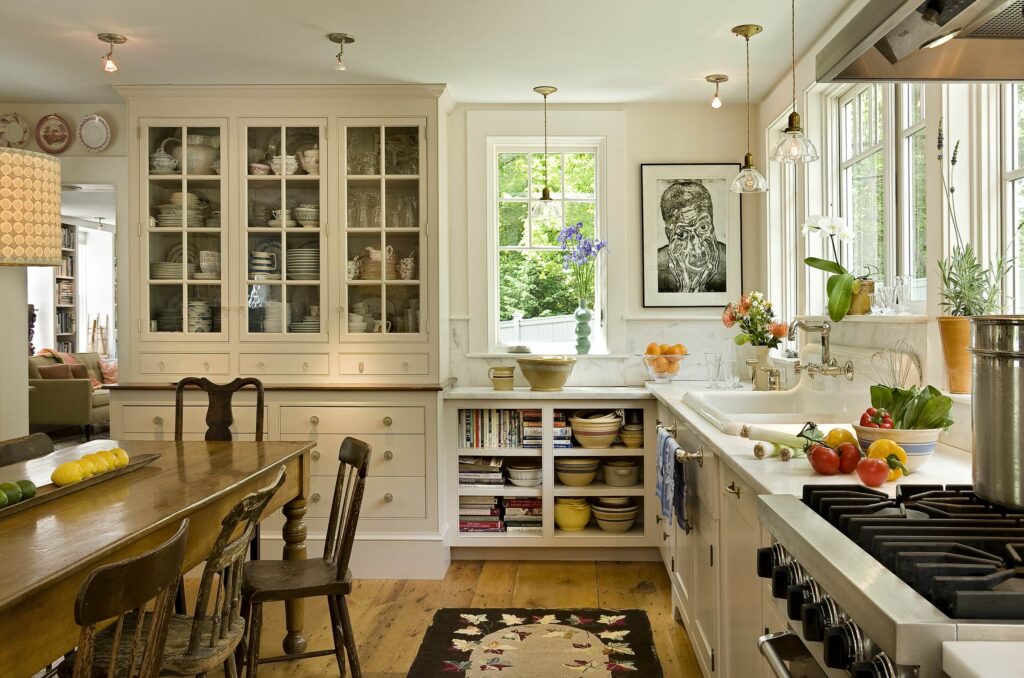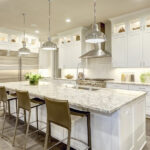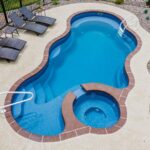When it comes to remodeling your kitchen, choosing the right design style can make all the difference in transforming this vital space into one that is not only functional but also reflects your personal taste. The kitchen is often referred to as the heart of the home, so it’s crucial that it feels inviting, comfortable, and aesthetically pleasing. In this article, we’ll explore various kitchen design styles that can be applied to different types of kitchen layouts, from small and cozy to large and spacious. Whether you’re into modern minimalism, classic tradition, or something in between, there’s a design style perfect for your kitchen remodel.
Modern Kitchen Design Styles for Small Kitchens
Modern design is particularly well-suited for small kitchens. With its focus on simplicity, clean lines, and functionality, modern kitchen design makes the most out of limited space while ensuring that the area remains sleek and stylish. Small kitchens can often feel cramped, but a modern approach can make the space feel more open and efficient.
Utilizing Minimalist Features in Small Kitchens
Minimalism is at the core of modern kitchen design, especially when it comes to small spaces. The key here is to keep things simple and streamlined. This involves choosing cabinetry with flat-panel doors, opting for built-in appliances, and limiting the color palette to a few neutral tones. By reducing visual clutter, you create a sense of openness. Glossy finishes and reflective surfaces, such as stainless steel or glass, can also help bounce light around the room, making it feel larger than it actually is. Additionally, opting for handleless cabinets and drawers can further enhance the sleek, minimalist look that defines modern kitchen design.
Incorporating Smart Storage Solutions
Storage is often a challenge in small kitchens, but smart solutions can help you make the most of every inch. Pull-out cabinets, vertical storage racks, and hidden compartments are essential in a modern kitchen remodel for a small space. These features allow you to keep your countertops clear and maintain the clean, uncluttered look that is central to modern design. Consider installing open shelving for frequently used items, which not only provides easy access but also adds to the modern aesthetic if styled correctly. Integrating appliances into the cabinetry can also free up counter space, further contributing to an organized and spacious feel.
Remodeling a Large Kitchen with a Contemporary Design Style
Large kitchens offer more flexibility in terms of design, allowing you to experiment with different layouts and incorporate a variety of features. A contemporary design style is perfect for a spacious kitchen, as it emphasizes open space, functionality, and a harmonious blend of different elements. This style is ideal for those who want a kitchen that feels modern and fresh but with a touch of warmth and personality.
Open Concept Layouts for Spacious Kitchens
One of the hallmarks of contemporary kitchen design is the open concept layout. This approach removes barriers between the kitchen and adjoining living or dining areas, creating a fluid space that encourages interaction and socialization. In a large kitchen, an open concept layout can include features like a central island or a breakfast bar, which serve as both a functional workspace and a gathering spot. By merging the kitchen with other areas of the home, you create a more cohesive living space that feels welcoming and inclusive. Large windows and sliding doors can further enhance the open concept by allowing natural light to flood the kitchen, making it feel even more expansive.
Integrating High-Tech Appliances and Features
Incorporating the latest technology is key to achieving a contemporary kitchen design. Large kitchens can accommodate a variety of high-tech appliances, from smart refrigerators to induction cooktops and built-in ovens with advanced cooking functions. These appliances not only make cooking more convenient but also contribute to the sleek, modern look of a contemporary kitchen. Additionally, features like under-cabinet lighting, touchless faucets, and integrated sound systems can enhance both the functionality and ambiance of the space. The use of modern materials such as quartz countertops and glass backsplashes can tie the entire design together, providing a polished, cohesive look.
Kitchen Remodel in a Traditional Design Style
For those who appreciate the charm and elegance of a classic kitchen, a traditional design style is an excellent choice. This style is characterized by its timeless appeal, featuring rich materials, detailed craftsmanship, and a warm, inviting atmosphere. Traditional kitchens are often seen as the epitome of comfort and luxury, making them a popular choice for homeowners looking to create a space that feels both elegant and homey.
Classic Elements in Traditional Kitchens
Traditional kitchen design is all about the details. Think ornate moldings, carved wood cabinetry, and antique-inspired hardware. These elements come together to create a kitchen that feels rich and inviting. In a traditional kitchen remodel, choosing high-quality materials like marble countertops, hardwood floors, and custom cabinetry can make a significant impact. The color palette typically leans toward warm, neutral tones, with natural wood finishes playing a central role. A central feature of many traditional kitchens is the use of a grand, statement-making range hood, often made from copper or other metals, which serves as a focal point in the room.
Balancing Functionality with Aesthetic Appeal
While traditional kitchens are undeniably beautiful, they also need to be functional. Balancing aesthetic appeal with practicality is key to a successful traditional kitchen remodel. This might involve integrating modern appliances in a way that doesn’t detract from the overall design. For example, panel-ready appliances that match the cabinetry can help maintain a seamless look. Additionally, incorporating ample storage solutions, such as pull-out pantry shelves and deep drawers, ensures that the kitchen remains both organized and user-friendly. The goal is to create a space that feels luxurious yet practical, where every element serves a purpose without compromising on style.
Rustic Kitchen Design Styles for Cozy Remodels
Rustic kitchen design is perfect for those who want to create a warm, cozy atmosphere in their home. This style is all about embracing natural materials and textures, creating a space that feels comfortable and lived-in. Whether you’re remodeling a country home or just want to bring a touch of rustic charm to your kitchen, this design style offers plenty of opportunities to create a welcoming, character-filled space.
Using Natural Materials and Textures
In a rustic kitchen remodel, natural materials are key. Wood is a dominant element, used in everything from exposed ceiling beams to cabinetry and flooring. Stone is another popular choice, often used for countertops, backsplashes, or even flooring. These materials bring a sense of authenticity and warmth to the kitchen, making it feel more connected to nature. Textures play a crucial role in rustic design as well—think rough-hewn wood, weathered finishes, and tactile fabrics like linen or burlap. These elements add depth and interest to the space, making it feel cozy and inviting.
Creating a Farmhouse-Inspired Kitchen
The farmhouse kitchen is a beloved variation of rustic design, characterized by its blend of practicality and charm. Key features of a farmhouse kitchen remodel include apron-front sinks, open shelving, and large, sturdy tables that serve as both a dining area and a workspace. Reclaimed wood is often used for cabinetry and countertops, adding a sense of history and character to the space. The color palette typically includes soft, muted tones like cream, sage green, and pale blue, which contribute to the kitchen’s warm and inviting atmosphere. Overall, a farmhouse kitchen is about creating a space that feels homely, functional, and timeless.
Remodeling Your Kitchen with a Coastal Design Style
As per Sheiner Construction, a reputable kitchen remodeling contractor in San Diego, “Coastal kitchen design is all about creating a light, airy, and relaxed atmosphere that evokes the feeling of being near the ocean. This style is perfect for those who want to bring a touch of the seaside into their home, even if they’re miles away from the coast. With its breezy layouts, light color palettes, and use of natural materials, a coastal kitchen remodel can transform your space into a tranquil retreat.“
Incorporating Light and Airy Elements
A coastal kitchen is characterized by its open, breezy feel. Large windows are essential, allowing plenty of natural light to flood the space and connect the indoors with the outdoors. In terms of layout, coastal kitchens often favor open concepts, with minimal barriers between the kitchen and adjacent living areas. This creates a sense of flow and openness, which is key to achieving the laid-back, beachy vibe of coastal design. Light, airy elements like sheer curtains, glass-front cabinets, and open shelving contribute to the overall aesthetic, making the kitchen feel bright and inviting.
Choosing the Right Color Palette
Color plays a significant role in coastal kitchen design. The palette is typically inspired by the colors of the sea and sky, with whites, soft blues, and sandy neutrals taking center stage. These colors not only make the space feel light and airy but also create a calming, serene environment. When remodeling your kitchen with a coastal style, it’s important to stick to this soft, muted color scheme to maintain the relaxing atmosphere. You can add pops of color with accessories like dishware, rugs, or artwork, but the overall look should remain light and soothing.
Industrial Kitchen Design Styles for a Bold Remodel
For those who prefer a more edgy, urban look, an industrial kitchen design is a perfect choice. This style is all about embracing raw materials, exposed structures, and a utilitarian aesthetic. An industrial kitchen remodel can create a space that feels both bold and functional, with a unique character that sets it apart from more traditional designs.
Exposing Raw Elements and Materials
The key to achieving an industrial kitchen design is to embrace the raw, unfinished look. This means exposing elements that are usually hidden, such as brick walls, concrete floors, and ductwork. Metal is another prominent material in industrial design, often used for lighting fixtures, countertops, and even cabinetry. The idea is to create a space that feels rugged and unpolished, yet stylish and functional. This style works particularly well in lofts or urban apartments, where the architecture often lends itself to an industrial aesthetic. However, it can also be adapted to other settings with the right approach.
Balancing Industrial Aesthetics with Comfort
While industrial kitchens are known for their bold, utilitarian look, it’s important to balance this with elements of comfort. Softening the harshness of exposed brick and metal with warm lighting, comfortable seating, and cozy textiles can make the space more inviting. Additionally, incorporating functional design elements, such as ample storage and efficient workspaces, ensures that the kitchen is not only stylish but also practical for everyday use. The goal is to create a kitchen that feels both industrial and livable, with a design that is as functional as it is visually striking.
Remodeling Your Kitchen with a Mid-Century Modern Design Style
Mid-century modern design is a timeless style that blends sleek lines with organic forms and a touch of vintage charm. It’s a great choice for those looking to create a kitchen that feels both contemporary and nostalgic. With its focus on functionality, simplicity, and natural materials, a mid-century modern kitchen remodel can transform your space into a stylish and efficient hub.
Incorporating Vintage and Sleek Design Elements
Mid-century modern design is all about clean lines and simple forms, often with a touch of retro flair. In the kitchen, this can translate to sleek cabinetry, streamlined appliances, and minimalist hardware. However, what sets mid-century modern apart is its use of organic shapes and materials. Curved countertops, rounded edges, and the integration of wood and glass can soften the space and add a touch of warmth. To keep the design feeling fresh, it’s important to balance these vintage-inspired elements with modern touches, such as state-of-the-art appliances or contemporary lighting fixtures.
Choosing Iconic Mid-Century Materials and Colors
The materials and colors you choose are crucial to achieving an authentic mid-century modern look. Wood is a staple of this design style, often used for cabinetry, furniture, and even walls. Teak, walnut, and oak are popular choices, providing a rich, natural feel. In terms of color, mid-century modern kitchens often feature a mix of bold and neutral tones. Think warm woods combined with pops of color like mustard yellow, olive green, or burnt orange. These colors, paired with white or light-colored walls, create a dynamic yet balanced space that feels both lively and inviting.
Eclectic Kitchen Design Styles for a Personalized Remodel
If you’re someone who doesn’t like to be confined by a single design style, then an eclectic kitchen remodel might be the perfect choice for you. Eclectic design is all about mixing and matching different elements to create a space that is truly unique and reflective of your personality. This style allows for creativity and experimentation, resulting in a kitchen that feels personalized and full of character.
Mixing and Matching Design Elements
In an eclectic kitchen, there are no strict rules—anything goes, as long as the overall look feels cohesive. This might involve combining elements from different design styles, such as pairing modern cabinetry with vintage lighting or mixing industrial elements with rustic touches. The key to pulling off an eclectic design is to find a balance between contrasting elements, ensuring that they complement rather than clash with each other. This can be achieved through a consistent color palette, the use of similar materials, or the repetition of certain design motifs throughout the space.
Balancing Bold Choices with Functional Design
While eclectic design allows for a lot of creative freedom, it’s important not to sacrifice functionality for the sake of style. A kitchen remodel should always prioritize practicality, ensuring that the space works well for cooking, dining, and socializing. In an eclectic kitchen, this means making bold design choices while still considering factors like storage, layout, and workflow. For example, you might choose an eye-catching, colorful backsplash, but balance it with neutral countertops and practical storage solutions. The goal is to create a kitchen that is both visually interesting and highly functional, reflecting your personal taste without compromising on usability.
Conclusion
Remodeling your kitchen is a significant undertaking, but with the right design style, it can transform your space into something truly special. Whether you’re working with a small kitchen or a large one, there’s a design style that can enhance both its functionality and aesthetic appeal. From the sleek lines of modern design to the cozy charm of rustic styles, each option offers unique benefits that can cater to your specific needs and preferences. By carefully considering your lifestyle, space, and personal taste, you can choose a kitchen design style that not only looks beautiful but also makes your kitchen a joy to use every day.



